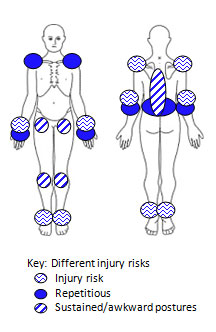Site labourer
Labourers have quite a physical role as their job tasks vary throughout the day assisting operators, pipe layers and surveyors. They constantly walk over uneven ground placing stress on their ankles, knees and hips. Labourers use their upper and lower body to erect fencing and signage around site. They also place stress on their shoulders, forearms and wrists with the use of hand tools.
Tasks and tools used
- erecting fencing
- shovelling
- use of hand tools
- assess/egress of trenches
- crawling through pipe
- administration
- communication via radio
- operating machinery
- operating of light vehicles
- carrying tools and equipment around site
Physical environment
- Outdoor conditions, e.g. sun, wind, rain and variable temperature
- Exhaust fumes
- Daylight
- Machinery vibrations
- Medium machinery and equipment noise
- Uneven and unstable terrain with variant degrees of gradient
- Dust in dry conditions
Risks – potential musculoskeletal injuries

Heavy risk
- Wrist, forearm and elbow strain: Repetitive tasks such as gripping involving the wrist and forearm increase risk of repetitive stress injuries.
- Lumbar muscle non-specific strain: Prolonged forward bending/stooping.
- Shoulder joint complex impingement/strain: Forceful and repetitive movements of upper limbs.
Medium risk
- Thoracic spine non-specific: Repetitive trunk rotation with variable load.
- Knee joint sprain/strain: Prolonged squatting or weight bearing on knee joint.
Light risk
- Hip joint inflammation: Prolonged weight bearing on hip joint.
- Ankle sprains/strains: Constant inversion and eversion movements to counteract uneven and unstable surfaces.
Critical physical job demands and other task requirements
Critical job demand descriptor | % of time the task is performed | Task |
|---|---|---|
| Constant | >66% |
|
| Frequent | 34%–66% |
|
| Occasional | <33% |
|
Suitable duties
- goals must be clear, realistic and achievable
- must have 'buy-in' from the worker
- worker helps to set the goals, and must be answerable if goals are not met (this allows barriers to RTW to be identified at an early stage and obstacles overcome)
- workers need to understand they have an obligation to participate in rehabilitation and RTW as per Section 232 of the Workers' Compensation and Rehabilitation Act 2003 (the Act).
Return to work suggestions
Worker can begin with light duties and include more tasks as their capacity for work changes. We'll work with all parties, including the treating medical provider, employer and worker to ensure everyone is aware of where the worker is with their rehabilitation and stay at, or return to work.
Note: some tasks are dependent on worker's injury and capacity, and some tasks may require the assistance of a co-worker.
Offsite
Return to work can begin at home for those having difficulty with transport, medication or the injury prevents them from returning to work.
If the worker needs to take a break from work, they're rehabilitation can still begin at home. Tasks can include:
- video on safety issues can be viewed (lying in bed if injury type requires)
- computer-based programs, CDs or DVD on work-related subjects
- phone-based work
- emails
- training
- other worksite inductions
- checking or auditing paperwork, e.g. helping the WHSO audit lost time injuries (LTIs) for a six-month period.
Host employment
In the event an employer is unable to provide suitable duties, a host placement may be required. If this is the case, the worker may be placed at a different employer in a graduated return to work plan until they're able to 'upgrade' back to his/her pre-injury role with their pre-injury employer.
WorkCover Queensland's Recover at work program places injured workers in short term host employment with employers who have an established track record of successful return to work outcomes with their own workers.
More return to work resources
- View physical demands photos for Site labourer